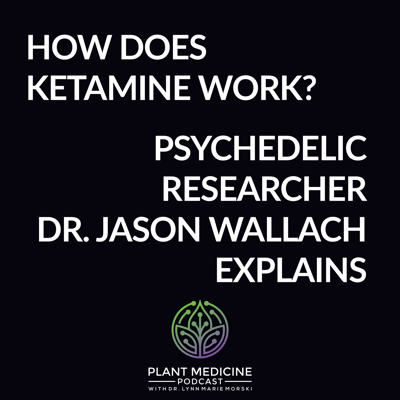Ketamine Scientific Research with Dr. Jason Wallach
- 29
- 10/01/2019

Summary
This week’s episode delves into the science behind ketamine therapy with Dr. Jason Wallach. Dr. Wallach has a Ph.D. in Pharmacology and Toxicology and is an instructor at the University of the Sciences. His research focuses on the analytical and pharmacological characterizations of psychoactive drugs with a focus on dissociatives and the serotonergic classical hallucinogens.
Dr. Wallach explains what the research says about the biochemistry of ketamine and how it actually works in the body. There’s still some debate about how ketamine’s various biochemical effects are involved in its therapeutic effects. Dr. Wallach shares what his research has discovered and the questions that he is still trying to answer.
Specifically when it comes to examining the potential uses of ketamine to treat depression, Dr. Wallach sees a lot of promise for the drug. He explains some of what the research has shown with ketamine’s use as an anti-depressant and how its effects differ from other treatments.
There has also been a lot of research into the difference between racemic mixtures of ketamine versus left-handed or s-ketamine. While racemic, which contains both the right and left-handed molecules, is what’s most widely used in the United States, new information is coming out regularly about the more targeted approach of s-ketamine.
Dr. Wallach explains what the research says about the biochemistry of ketamine and how it actually works in the body. There’s still some debate about how ketamine’s various biochemical effects are involved in its therapeutic effects. Dr. Wallach shares what his research has discovered and the questions that he is still trying to answer.
Specifically when it comes to examining the potential uses of ketamine to treat depression, Dr. Wallach sees a lot of promise for the drug. He explains some of what the research has shown with ketamine’s use as an anti-depressant and how its effects differ from other treatments.
There has also been a lot of research into the difference between racemic mixtures of ketamine versus left-handed or s-ketamine. While racemic, which contains both the right and left-handed molecules, is what’s most widely used in the United States, new information is coming out regularly about the more targeted approach of s-ketamine.
In This Episode
• What the current research says concerning ketamine’s biochemical effects in the body
• The connection between ketamine and glutamate receptors and what this could mean for its anti-depressant effects
• Studies into ketamine’s use as an anti-depressant and what this suggests about its efficacy
• Ketamine as a treatment for various chronic pain conditions
• The difference between racemic ketamine and s-ketamine
• The future of ketamine trials
Quotes
“What ketamine does is it blocks the NMDA receptor preventing that flux of information from outside the cell to inside the cell.” [5:46]
“Most existing anti-depressants have a delay in their onset. They take several weeks before you see any effect. Whereas with ketamine they can be observed within 40 minutes and peak within a day or so.” [10:45]
“I suspect that maybe for a subset of people with depression, maybe even PTSD, chronic pain, or OCD, those experiences might have additional efficacy above and beyond what is occurring with the sub-hallucinogenic doses of ketamine that are currently being used.” [24:41]
“Most existing anti-depressants have a delay in their onset. They take several weeks before you see any effect. Whereas with ketamine they can be observed within 40 minutes and peak within a day or so.” [10:45]
“I suspect that maybe for a subset of people with depression, maybe even PTSD, chronic pain, or OCD, those experiences might have additional efficacy above and beyond what is occurring with the sub-hallucinogenic doses of ketamine that are currently being used.” [24:41]
Links
* The Psychedelic Medicine Podcast has allowed the Psychedelic Medicine Association to post episodes as an educational resource, and in return the PMA is hosting the podcast show notes.


